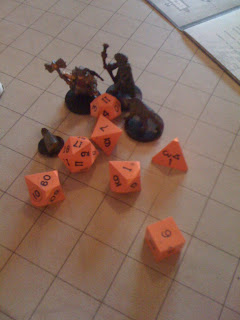 |
| GameScience Dice in action |
So I dusted off Angus the Artificer and we picked up where we left off in the module Whispers of the Vampire's Blade. But before I could start playing I had an important ritual to complete with my new dice: coloring in the numbers. The opaque dice I selected at Origins (a nice dusty orange) did not come with painted numbers.
This didn't bother me in the least. See, the first (and second) set of gaming dice I acquired (and proudly still own) did not come with painted numbers either: the red Basic and blue Expert boxed sets of D&D. Those sets even came with a white crayon for the purpose of coloring in the numbers (yes, I still have the pieces of that original crayon in my dice bag; I'm working through this with my therapist); the GameScience dice did not. No biggie, I could borrow one from my boys.
(Some of you may be asking why I didn't use that original crayon for coloring in my new dice. Well, obviously, that crayon is only used for touch-up on the original dice. Yes, it is a sickness and admitting it is the first step to recovery.)
So, for the first time in 30 years I set to coloring in my dice. The artist in me settled on a dark blue-violet (I have to justify those years earning my BFA from time to time). I started with the d6, scraping the point of the crayon over each face. You see, the numbers on each die are indented, so, rubbing the crayon over these presses the dark wax into the recesses. It also sticks to the surface of the die; not very legible or pretty at this point. That is where the tissues come in.
The next step after coloring is polishing each die with tissues (a brand without lotion preferably, generic is preferred). Well, maybe not so much polishing as cleaning off the excess crayon. Throughout this process I'm turning the die over and over in my hand, feeling each side, each edge. In this way I'm getting to know each die. I notice at the edges are crisp and sharp. I also notice the rough spot where the die was broken off the 'tree' much like the parts of a plastic model kit.
This rough spot is a point of pride with the GameScience dice makers. It proves that the dice were not put through a tumbler to polish out the blemishes. Such polishing does smooth away the blemishes, but it also rounds the edges and results in unevenly-sized dice. By the way, that's also how dice with painted numbers are made: the dice are painted then polished to remove the paint from the sides while leaving it in the numbered recesses.
By the time I finished with my dice I was ready to start rolling. I gave each a few experimental rolls. I would drop each die from my hand at varying heights over the table. We were playing on a Chessex battle mat so it provided an even and slightly springy surface.
I was surprised to see that each die would bounce one or twice and then stop, even the d20. This was way cool. The sharp edges brought each die to a stop with a minimum of rolling. No more chasing run-away dice across the table. I could see that there would be much less sloppy die rolling in my future. As we played I paid attention to the results of each roll. While I did not try to stat the rolls I did feel that the results were suitably random enough for my tastes.
The end result is that I am very happy with my GameScience dice and I can't wait to get more. They have a great nostalgic quality and I can feel reassured that the dice are going to be impartial oracles. Now I wonder if the GameScience folks make Fudge dice too?
Follow your bliss,
JJ
- Posted using BlogPress from my iPad

I have 2 sets of Gamescience dice and I have to wonder how the rough spot effects the rolls. Sure, the sides are perfectly even, but wouldn't the rough spot introduce bias? I wonder how Vegas dice are made....
ReplyDeleteI haven't seen any bias yet. Longer use may reveal something. I believe that the GS folks use a process similar that for Vegas dice or at the very least produce similar quality, but I think the talk about that on their website.
ReplyDeleteI picked up a set a GenCon. I love em! Anyone interested in how the dice are made should really check out these videos of Louis Zocchi at GenCon 2008...
ReplyDeletehttp://www.youtube.com/watch?v=bR2fxoNHIuU
http://www.youtube.com/watch?v=PxmkWrDbn34&feature=related
@canageek - The second video explains the difference in how RPG dice and Casino dice are made.
ReplyDelete@Labyrinthian thanks for the links.
ReplyDeleteUnfortunately, I think that some kind of IP law means that only Grey Ghost can sell Fudge Dice. Means we're stuck with they kind of lame colors that they produce. :(
ReplyDelete@Nick, I think you are correct. I looked on GS site and found no Fudge dice for sale. I can always use their regular d6.
ReplyDelete